Fake News

-
Safeguarding Yourself From Fake News - 8 Mar 2023 (Video)
Over the years, the threat of fake news and online misinformation has evolved in their forms and impact on society. In this talk, learn about the characteristics of fake news, the psychological reasons why people fall victim to them and measures on how to safeguard yourself against them using NLB’s S.U.R.E. steps (Source, Understand, Research, Evaluate).
This webinar was recorded on 8 March 2023, as part of NLB’s Defending the Little Red Dot campaign which consisted of talks, book displays and film screenings, highlighting stories of resistance and resilience during the Japanese Occupation, and the importance of preparedness in the digital age.
Download the slides here.
-
Be S.U.R.E. before you share: Breaking news
As more people turn to social media to get the latest updates on breaking news, how can we be S.U.R.E. of what we read online? Watch this video on how to be S.U.R.E. before you share on a story that is still developing.
-
S.U.R.E Skills Series for Seniors -Verifying Images & Videos
Received an image that you suspect is fake, but cannot be sure? Discover tools to check for dubious images and videos.
Download the slides here.
About the Programme
Received an unsettling image via your WhatsApp chat group that you suspect is fake, but cannot be sure? Discover useful online tools to check for dubious images and videos.
S.U.R.E. stands for Source, Understand, Research and Evaluate, and is an initiative of the National Library to educate the public on information literacy. For more information and free resources, please visit us at sure.nlb.gov.sg
-
S.U.R.E Skills Series workshop - How to Be A Smart Fact-Checker
Learn useful tips and techniques in fact-checking suspicious messages or posts you receive.
Download the slides HERE.
S.U.R.E. stands for Source, Understand, Research and Evaluate, and is an initiative of the National Library to educate the public on information literacy. For more information and free resources, please visit us at sure.nlb.gov.sg -
S.U.R.E Series for Seniors: Spotting Deepfake Images and Videos
Learn about Artificial Intelligence-generated deepfake images and videos.
Download the slides HERE.
S.U.R.E. stands for Source, Understand, Research and Evaluate, and is an initiative of the National Library to educate the public on information literacy. For more information and free resources, please visit us at https://www.nlb.gov.sg/main/site/sure-elevated.
-
银发族S.U.R.E技能系列:如何识破 “深度伪造” 图像和影像
通过这个工作坊,您能了解什么是利用人工智能(AI)合成的“深度伪造” (Deepfake) 图像和影像,以及如何识破它们。
Download the slides HERE
随着科技的进步,假造的图片及影片几可乱真,庆幸的是识别真伪的技术也十分先进。通过这个工作坊,您能了解什么是利用人工智能(AI)合成的“深度伪造” (Deepfake) 图像和影像,以及如何识破它们。本工作坊是银发族S.U.R.E.技能系列的最后一个部分。本工作坊是银发族S.U.R.E.技能系列的第三部分,适合50岁及以上的朋友们参加。
-
银发族S.U.R.E技能系列:如何查证图像和影像的真伪
您是否曾经从社交群组里收到令人感到不安的图像,觉得很可疑却又不能确定?一起来参加这个工作坊,学习如何使用网上的查证工具来核实可疑图像和影像的真伪吧!
Download the slides HERE.
-
S.U.R.E Series for Seniors: Verifying Images & Videos
Received an image that you suspect is fake, but cannot be sure? Discover tools to check for dubious images and videos at this workshop.
Download the slidesHERE.
S.U.R.E. stands for Source, Understand, Research and Evaluate, and is an initiative of the National Library to educate the public on information literacy. For more information and free resources, please visit us at sure.nlb.gov.sg
-
S.U.R.E Skills Series workshop - Safeguarding Your Mind Against Fake News
Learn more about the psychological reasons behind the spread of fake news, and more importantly, what YOU can do about it.
Download the slides HERE.
S.U.R.E. stands for Source, Understand, Research and Evaluate, and is an initiative of the National Library to educate the public on information literacy. For more information and free resources, please visit us at sure.nlb.gov.sg
-
银发族 S.U.R.E. 技能系列: 如何避免受假信息影响
这个工作坊将能让您了解人们撒播假信息背后的心理因素,以及您能如何协助制止假信息的传播。
Download the slides HERE.
-
S.U.R.E. Skills Series for Seniors: Safeguarding Your Mind From Fake News
Learn more about the psychological reasons behind the spread of fake news, and more importantly, what you can do about it.
Download the slides HERE.
S.U.R.E. stands for Source, Understand, Research and Evaluate, and is an initiative of the National Library to educate the public on information literacy. For more information and free resources, please visit us at sure.nlb.gov.sg.
-
Story Books: What’s “Truth” in a Non-Fiction Text?

It took me a long time to learn to read, when I was a child, but once I did, I read everything: menus, manuals, advertisements. I’d follow my parents to the supermarket and hover in front of the freezers, reading the words on the chicken nugget boxes. I used to go everywhere with a book wedged under my little arm, sometimes two: joke books, trivia books; books about science and maths and history. And, of course, my favourites: all those books of fiction, the chapter books and short novels and anthologies. The storybooks.
I read less and less non-fiction as I grew older, and by the time I was a teenager I was reading fiction almost exclusively. My mother, who loves facts, found this very distressing.
“You love reading so much,” she used to say, “why don’t you read something informative? Like a biography, or the encyclopaedia?”
“Because they’re boring,” I would reply. “I don’t like reading information. I like reading stories.”
This carried on for years; in fact, it was only once I started working that I began, slowly, to read non-fiction again. And, as I did so, I started to remember something that I had forgotten a long time ago, something that I had known when I was just a child poring over our new TV’s instruction manual: that, actually, all books are storybooks. That all information, all facts, are really just stories in disguise.
What do I mean by this? We often believe that there are two kinds of statements about the world: facts, which are objective, verifiable, and neutral; and opinions, which are subjective and therefore somewhat untrustworthy. We also tend to assume that “factual” is the same as “truthful”: that claims that appear to be objective are more likely to be true than those which are clearly based on a particular perspective or interpretation. This is where the idea of bias comes from, and also why so much trust is placed in data – why we tend to believe that numbers, unlike people, cannot lie.
But as any statistician will tell you, numbers can, and in fact do, lie all the time. This is because numbers cannot actually tell us anything without the aid of human interpretation, and can often support multiple different interpretations at once. Statistics are also extremely susceptible to manipulation, and the choices that statisticians make in choosing what data to collect and include can dramatically change the results they produce: as Kalev Leetaru points out in an article for Forbes, many apparent “truths” drawn from data are, in fact, “factually true statements that utilize such a carefully constructed population sample that their argument is almost meaningless”.
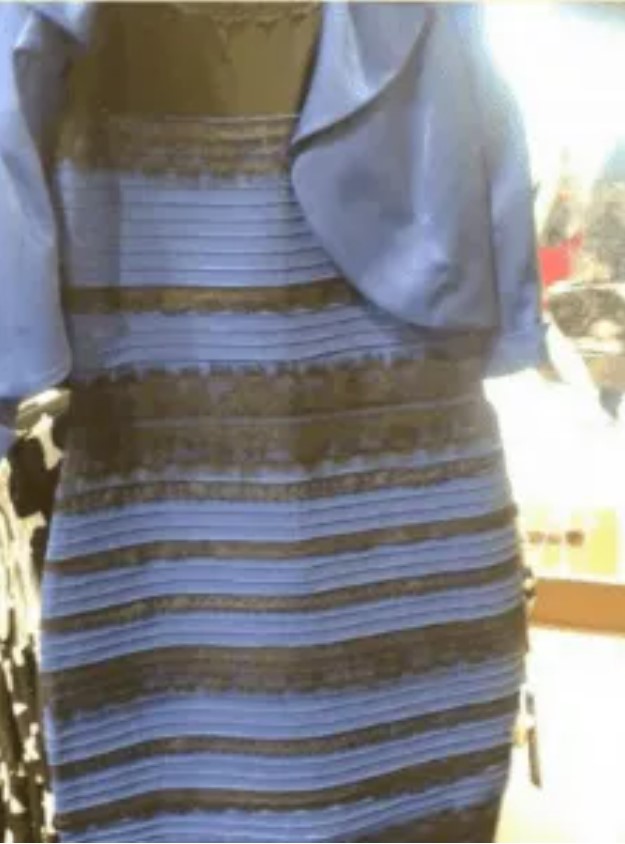
What colour is this dress?(Photo Source
It’s clear that the conclusions we draw from supposedly objective data are often as much a reflection of our perspectives and assumptions as they are of “truth”. This applies to all kinds of data, including everyday observations; when we look up and see that the sky is blue, we are in fact interpreting the raw data our eyes receive about the wavelength of light from the sky. As the 2015 meme surrounding that one blue-and-black – or was it white-and-gold? – dress proved, these interpretations can be more subjective than we expect. As vision scientist Pascal Wallisch writes, “people’s perceived [colour] is also informed by their perception of lighting”, and this in turn is often based on “the viewing history of the individual observer” and the assumptions this history creates. Our past experiences literally change the way we see the world.
The process of turning data into “facts” is, therefore, less a search for truth than an attempt to create meaning: to string bits of information, expectation, and thought together to create a message that makes sense. It is, in other words, an act of storytelling.
What this means is that there is no such thing as a fully objective statement. It is not actually possible for information to be totally free of bias, since our perceptions of data and of reality are always informed by our beliefs, assumptions, or history. This does not mean that every claim is equally true or trustworthy, or that we can never really trust a “fact” again; it does mean, though, that whenever we encounter these claims, whether in an opinion piece or in a supposedly objective non-fiction book, we must first think about what their underlying assumptions are, and whether we do – or can, or should – agree with these assumptions.
A history book about the reasons for the end of the Cold War assumes, among other things, that the Cold War existed, that it ended, and that it ended for specific reasons that can be known and understood. A book about healthy eating assumes not just that certain foods are good for your body, but also that a certain type of body – typically a thin one – is “good” and “healthy”, while others are not. A book about how to get rich assumes that getting rich is a good thing, that it is possible for anyone to get rich, and that readers will all be able and willing to take the actions the book suggests.
Each of these books also assumes that the data they use to prove their points is accurate and trustworthy, that their logic holds together, and that the authors themselves, in telling the stories that they tell, are acting in good faith. We can choose to share, agree with, or just accept any or all of these assumptions as we read – but we must be aware that this is something we are doing, and understand why we have chosen to do it.
This choice may sound daunting, but it is one of the things I love most about reading. In choosing not just what books to read, but also which stories to believe and which perspectives to trust, I am able to be in charge of what I know. By recognising the storytelling involved in non-fiction texts, I can read them not as a passive recipient of facts but as an active participant, evaluating each claim for myself and using my own judgment to draw my own conclusions.
And, in doing so, I catch a glimpse of the wonder I had as a child – the same magic that made me read every word I could see, confident that each and every one of them contained endless stories that I could discover for myself.
This article was written by Kimberley Chiu.
Kimberley is the Associate Librarian in charge of the adult collection at Ang Mo Kio Public Library. She likes cats, books, and coffee, and spends most of her free time reading fanfiction and watching overlong videos on YouTube. She co-hosts a podcast on film adaptations, and is currently working on a novel.
References:
Kalev Leetaru, “Lies, Damned Lies And Statistics: How Bad Statistics Are Feeding Fake News”. Article in Forbes, published 2 February 2017. https://www.forbes.com/sites/kalevleetaru/2017/02/02/lies-damned-lies-and-statistics-how-bad-statistics-are-feeding-fake-news/?sh=5eb81c7350ca, accessed 6/4/21.
Pascal Wallisch, “Two Years Later, We Finally Know Why People Saw “The Dress” Differently”. Article in Slate, published 12 April 2017. https://slate.com/technology/2017/04/heres-why-people-saw-the-dress-differently.html, accessed 6/4/21.
-
S.U.R.E Skills Series workshop - Detecting Fake Videos and Images
Learn more about the rising threat of manipulated images & deepfake videos used in fake news, and how to detect them with online tools.
Download the presentation slides HERE
S.U.R.E. stands for Source, Understand, Research and Evaluate, and is an initiative of the National Library to educate the public on information literacy. For more information and free resources, please visit us at sure.nlb.gov.sg
-
What Comics Teach Us About Fake News
I am a huge fan of comics. I love their glossy pages, their bright colours, their weird character designs. I love beautiful comic art, and I love the stories that only comics can tell: stories full of emotional depth and character complexity, or brimming with action and excitement, or set in worlds too strange and fantastic for even the wildest of movie budgets.

But comics aren’t just fun; they’re also part of a unique medium with its own complex rules and capabilities. Comics are visual stories which depend on powerful images; they pack huge amounts of information into a small space and rely on readers to fill in the blanks. The techniques comics use to tell their stories can move and delight us – but these same techniques can, in other settings, also be used to mislead or manipulate us.
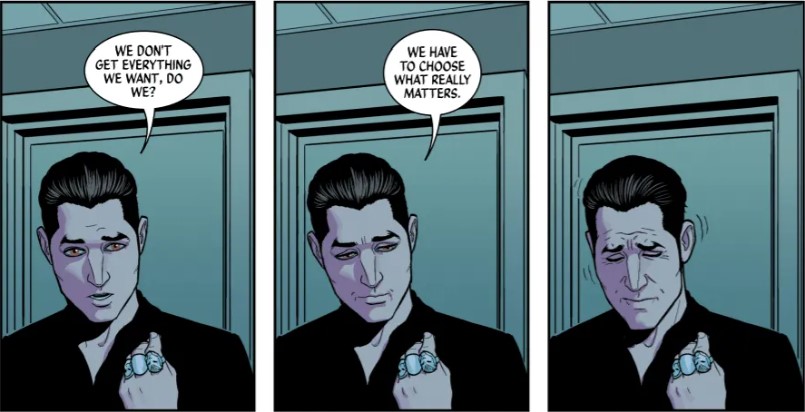
The Wicked + The Divine. Written by Kieron Gillen, line art by Jamie McKelvie, colours by Matt Wilson.
These three panels from The Wicked + The Divine, an Eisner-award-nominated comic series which ran from 2014-2019, demonstrate the power of images to convey information. The panels convey not only factual information – telling us where we are and who is speaking – but emotional information as well. The sharp angles and minimalist lines of the background create a feeling of harshness and emptiness; the colour palette of washed-out greys, blacks, and blues suggest both sadness and sterility. And, of course, there are the facial expressions and body language of our speaking character, Cameron, which are amplified and emphasised by the way he dominates each panel. These images form a vivid picture of his internal landscape, and his shift from surety to wry resignation and, finally, to a quiet breakdown.
Even without reading the speech bubbles, and without knowing the wider context of this scene, we can read a whole story out of these three panels: a story about a single character’s anguished resolve in the face of limited options; a story which emphasises the importance of that character’s emotional journey and asks us to sympathise with him. These images, despite their apparent simplicity, pack a lot of complex information into a small space; they are able to convey facts, feelings, and even a whole worldview.

What does this have to do with misinformation? Well, while most writing about information literacy focuses on written content, the powerful use of visual information in comics reminds us that images, even those that seem simple or innocuous, can make us think and feel things too. Pictures don’t have to outright lie to mislead us: even a genuine, authentic image, like an unedited photograph, can mislead us by suggesting untrue ideas and conclusions, or by making us feel emotions – like fear and outrage – that cloud our judgment. Graphic images of violence or destruction, for instance, often make us react strongly and emotionally, and thus create powerful and immediate reactions which might not take into account the images’ context.
This happens because we all have the instinctive ability to “read†images, but it also happens because of a technique called “closureâ€. The term was coined by Scott McCloud in his book *Understanding Comics*, and it refers to a reader’s ability to fill in the gaps between two images, or between two pieces of information, that are placed side by side.
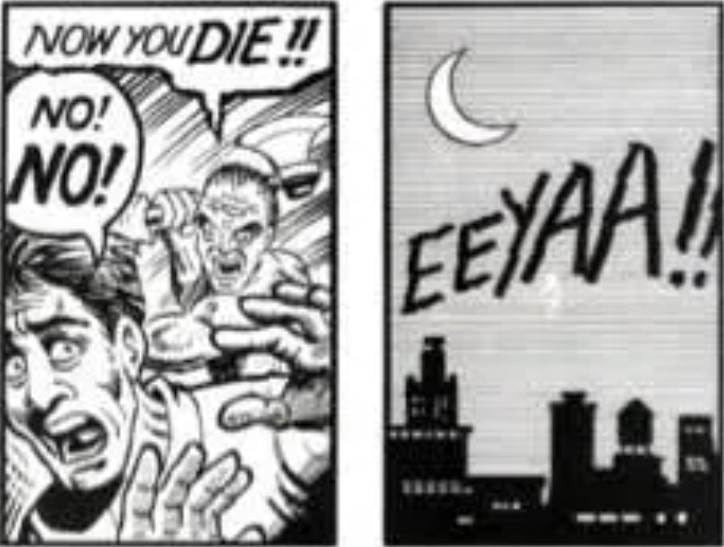
Panels from Understanding Comics by Scott McCloud.
In this example from Understanding Comics, we see two images: one of a man being chased by an attacker with an axe, and one of a city skyline with a scream written over it. A reader looking at these images easily and naturally draws certain conclusions: that the scream in the second image belongs to the attacked man in the first, and therefore that he has been caught by his attacker and hurt, or even killed, with the axe. Yet these conclusions are never stated to us – we never see the man getting attacked. They are simply suggested by the way these pieces of information are placed. Our brains have filled in the gaps, and created the story, on their own.
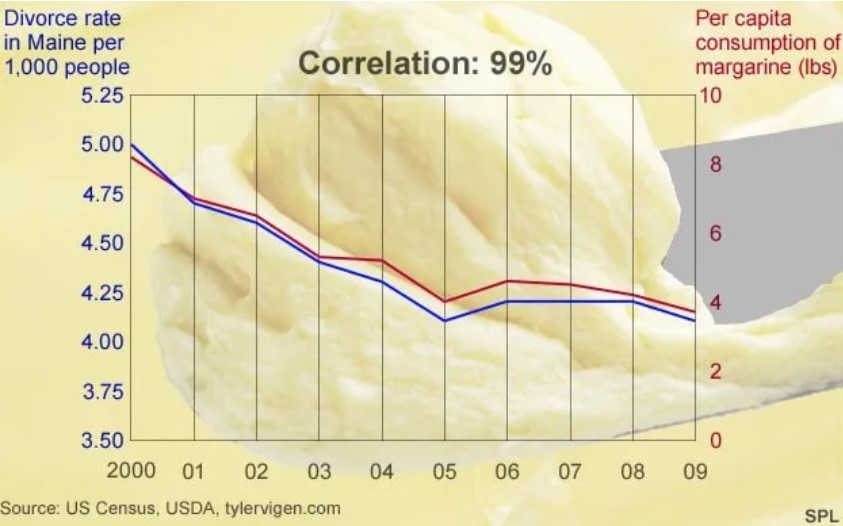
Eating margarine… causes divorce? [Source]
Closure is often exploited by creators of misinformation to suggest certain relationships between events or pieces of information which may not exist in reality. For instance, a misleading news article may present unrelated statistics side by side, making us believe that one thing has caused or affected the other. Or a website might publish a headline, like “my cancer miraculously went away!â€, alongside an unrelated image, like a picture of a bag of rice. The way such information is placed might lead us to a conclusion – in this case, that rice cures cancer – that is untrue and, if stated outright, might even sound unbelievable.
Comics show us the power of images, and of our own minds, to create whole stories around small pieces of carefully-placed information. In doing so, they show us how this very power can be used against us. As if we needed more reasons to think critically about the stories we read – or more reasons to think comic books are cool!
This article was written by Kimberley Chiu.
Kimberley is the Associate Librarian in charge of the adult collection at Ang Mo Kio Public Library. She likes cats, books, and coffee, and spends most of her free time reading fanfiction and watching overlong videos on YouTube. She co-hosts a podcast on film adaptations, and is currently working on a novel.
References:
[https://theconversation.com/out-of-context-photos-are-a-powerful-low-tech-form-of-misinformation-129959](https://theconversation.com/out-of-context-photos-are-a-powerful-low-tech-form-of-misinformation-129959)
[https://www.bbc.com/news/magazine-27537142](https://www.bbc.com/news/magazine-27537142)
[http://www.tylervigen.com/spurious-correlations](http://www.tylervigen.com/spurious-correlations)
[https://time.com/3605606/ferguson-in-defense-of-rioting/](https://time.com/3605606/ferguson-in-defense-of-rioting/)
The Wicked + The Divine, by Kieron Gillen and Jamie McKelvie. Image Comics, 2019.
Understanding Comics: The Invisible Art, by Scott McCloud. Tundra Publishing, 1993.
-
Watch Out for Manipulated Content

In today’s world, false information is chipping away our trust in media, people and resources around us. As we spend much time in the online space, it is more important than ever to separate truth from fiction.
The election period will see a tremendous volume of online campaigning and civic participation. Much of this is now being done in new and creative ways – engaging videos, relatable memes, catchy and viral multimedia content shared through social media and private messaging.
On the receiving end of this flood of information and material, we must all be even more cautious and alert than before – to avoid being victims of scams, misinformation, and even interference in our elections.
Overseas, there have been many examples of videos and photographs being doctored to influence politics. No sophisticated tools or techniques are necessary to create such deceptive content. Many would be familiar with these incidents:
- A video of a politician was slowed down to make it sound like she was slurring, to mock and discredit her.

Doctored video of US politician Nancy Pelosi
Source: The Guardian
- An image of a politician waving a flag was edited to replace it with a different flag, inflaming tensions in a fragile situation.

Doctored and original photos of Hong Kong politician Junius Ho
Source: AFP Fast Check
- Even celebrities have had their photos edited by others, to associate them with political movements.
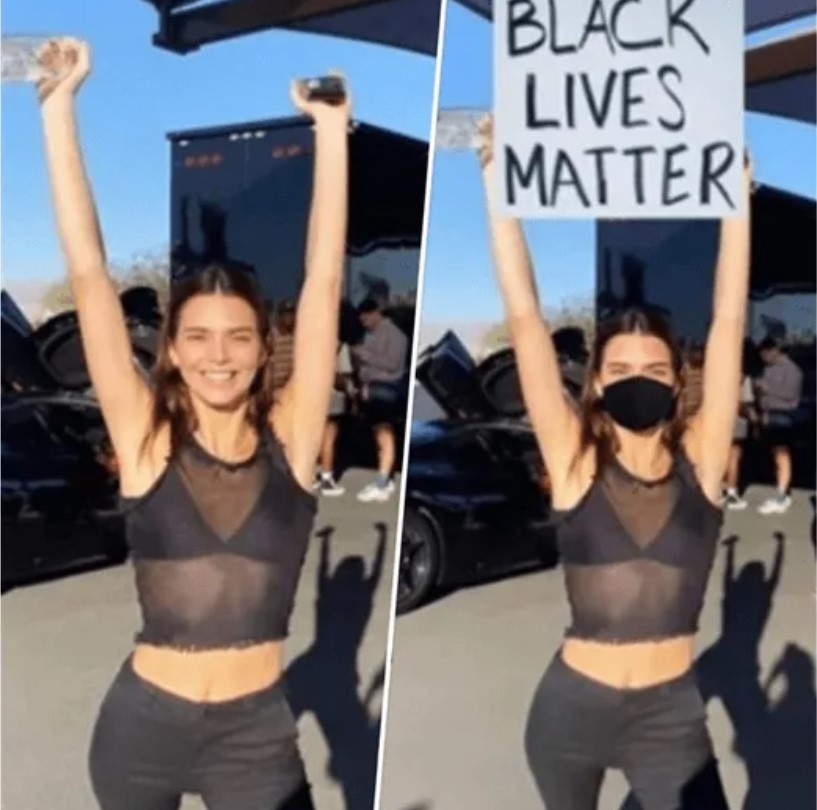
Original and edited image of US celebrity Kendall Jenner
Source: Yahoo News
Over the election period, we may well see more manipulated content, given the ease with which it is created and spread. For instance, in Singapore, there has already been a confusing video circulating on WhatsApp, which appears to show people overseas carrying banners and slogans related to our local politics. These are actually clips from movies and other videos, which were edited to superimpose those slogans. The video editing software that was used is one of many that can be downloaded online for free.
When it is hard to tell the truth, we are less able to make well-informed decision in many situations. Here are 4 SURE steps to help you discern information:
Source: On social media platforms, check the post’s origin and see if it is an authentic web source. Some fake news originate from dubious web sources that imitate official websites by adding in an extension to the web address.
Understand the difference between factual information and opinions. Content based on facts are not influenced by personal feelings, opinion or beliefs. News story should give accurate information and be objective (opinion-free).
Research: Go beyond the initial source. Do a quick search of any suspicious news you receive. Treat it with suspicion if there is lack of news coverage or evidence. Find at least two or more sources to confirm if the information is real. Use credible sources to find out if an article or message you received is authentic.
Evaluate: Look for a balance in all points of views (different perspectives) in the information you are reading. There are at least two sides to every story. Also consider if the headline, video or photo has been doctored or faked to fit a certain narrative.
Be SURE before you choose to believe, share or forward the information!
Download our infographic HERE
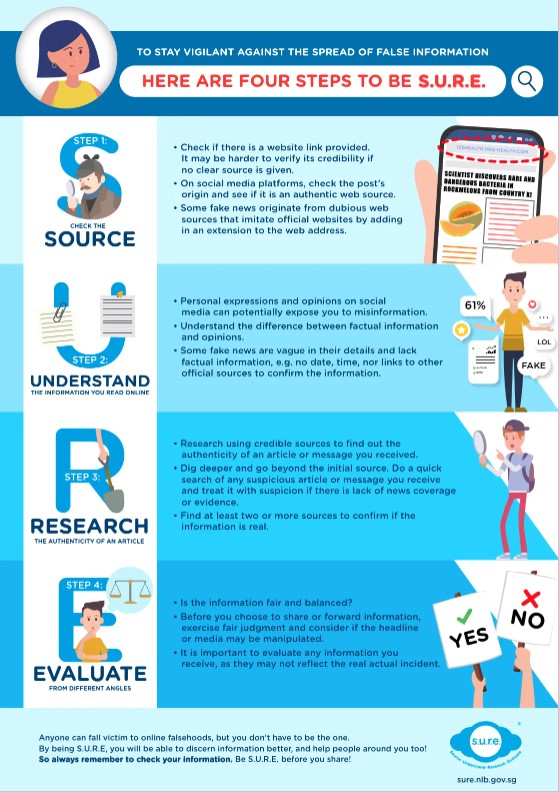
-
How to be S.U.R.E. of your COVID-19 Information
-
COVID-19 Quiz
COVID-19 news: Real or Fake?
Your friend or family member sends you a well-intentioned message about COVID-19. Are you able to tell if it is real or fake?
Note:
In each section, you will be shown a message about the COVID-19 outbreak. Please tell us: 1) if it is real or fake (required) 2) how did you arrive at your answer (optional) 3) if you have ever encountered it before (optional)
-
How to be S.U.R.E. before you share (e-Presentation and infographic)
Hi everyone,
We have a new e-Presentation and new infographic on applying the four S.U.R.E. steps to verify dubious information. Feel free to share this with your family and friends!
[e-Presentation] How to be S.U.R.E. before you share
Learn how to safeguard yourself and others against online falsehoods by using the National Library Board’s S.U.R.E. steps HERE.
[Infographic] How to be S.U.R.E. before you share
How to be S.U.R.E. before you share
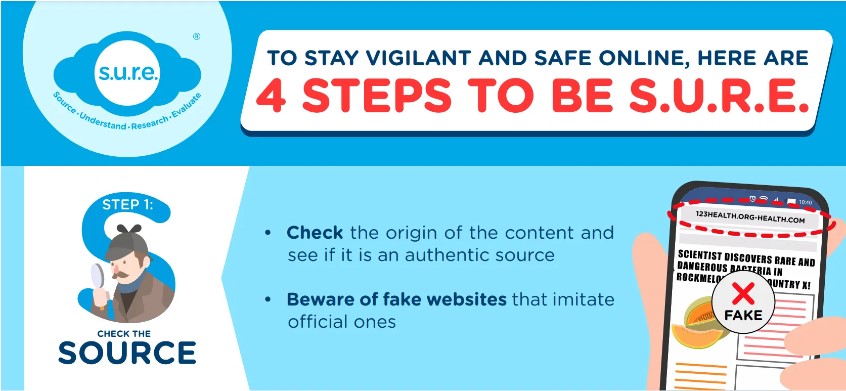
This infographic is also available in:
Check out the SURE animated video HERE
-
COVID-19 Resources
Hi everyone,
We have started a new resource section on fake news relating to the current COVID-19 situation.
There is a list of fact-checking tools as well as a list of credible websites you can refer to.
We will be adding new materials soon.
-
How to be S.U.R.E. before you share (Videos)
Learn how to safeguard yourself and others against online falsehoods by using the National Library Board’s S.U.R.E. steps.
Check out the infographic and e-presentation from the same series HERE
This video is also available in other languages: